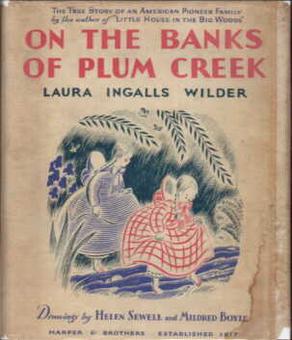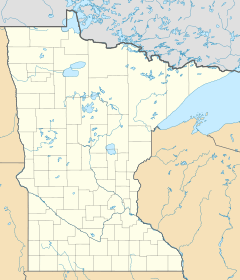On the Banks of Plum Creek facts for kids

Front dust jacket with Sewell's illustration
|
|
| Author | Laura Ingalls Wilder |
|---|---|
| Illustrator | Helen Sewell and Mildred Boyle Garth Williams (1953) |
| Country | United States |
| Language | English |
| Series | Little House |
| Genre | Children's novel Family saga Western |
| Set in | Redwood County, Minnesota, 1874–76 |
| Publisher | Harper & Brothers |
|
Publication date
|
October 20, 1937 |
| Media type | Print (hardcover) |
| Pages | 239; 338 pp. |
| OCLC | 1291009 |
| 813.52 | |
| LC Class | PZ7.W6461 On |
| Preceded by | Little House on the Prairie |
| Followed by | By the Shores of Silver Lake |
On the Banks of Plum Creek is a children's novel by Laura Ingalls Wilder. It was published in 1937. This book is the fourth in her famous Little House series. It tells the true story of Laura's childhood. The book covers the years when her family lived near Plum Creek in Walnut Grove, Minnesota. This was during the 1870s.
The novel was recognized as a Newbery Honor book in 1938. Many other Little House books also received this award.
Contents
Adventures on Plum Creek
The Ingalls family leaves their small house in Kansas. They travel by covered wagon to Minnesota. They settle down by Plum Creek. Pa trades their horses for a dugout home and a stable. Later, he gets two new horses for Christmas. Laura and her sister, Mary, name them Sam and David.
Pa soon builds a new wooden house above ground. He hopes their first wheat crop will pay for the wood.
School Days and New Friends
Now that they live near a town, Laura and Mary go to school. This is their first time attending school. They make new friends there. They also meet Nellie Oleson, the storekeeper's daughter. Nellie often makes fun of Laura and Mary. She calls them "country girls."
Laura and Mary go to a party at Nellie's house. Ma then invites all the girls to their own party. Nellie is rude to Ma and mistreats the Ingalls' dog, Jack. But Laura feels better when Nellie gets covered with leeches while wading.
Facing Hard Times
The Ingalls family faces very difficult times. A huge Locust Plague of 1874 destroys their wheat crop. This means they cannot harvest any wheat. It also ruins the chance for a good crop next year.
For two harvest seasons, Pa must walk about 300 miles east. He needs to find work on other farms. The community's school closes because of this disaster. This means the girls cannot go to school anymore.
A Blizzard and Homecoming
A very bad blizzard hits for four days. It delays Pa's return home. Ma plays games with the girls to keep them happy. Finally, Pa arrives home safely. It turns out he was very close to the house during the storm. He just couldn't see it in the blinding snow. The novel ends with the family happily together on Christmas Eve.
About the Book's Creation
After facing tough times farming in the Dakotas, Laura Ingalls Wilder moved. She moved with her husband, Almanzo, and daughter, Rose. They settled in Missouri. Years later, Rose encouraged her mother to write about her childhood. Laura had been writing for a farm newspaper.
Laura first wrote a story about her life called Pioneer Girl. It was for adults. When publishers did not buy it, Rose suggested they change it. This led to the Little House book series. Some real-life events were made simpler for younger readers.
See also


